The beginning of the movement on the automatic machine. Rules for driving an automatic transmission
If drivers are asked which gearbox is better, then opinions will be divided. Someone is more accustomed to driving a mechanic, but it’s difficult for someone without a machine gun. In this article we will analyze how to learn how to drive an automatic.
Start of movement
Every trip starts with starting the engine and then warming it up. Don't start moving right away. When the temperature is positive outside, the car will need a couple of minutes for the oil to be distributed evenly over the box. The lower the temperature, the longer it takes to warm up the car, so in winter people stand for more than 10 minutes. You also need to remember that you can start the car only when the gearbox is in the “P” or “N” position, preferably with “P”. In some cases, if you do not have this position turned on, then you will not be able to start the car.
When the car has warmed up, you can go. Switch the lever from position "P" to "D" and wait for a slight push. It will take no more than two seconds, but if you suddenly press the gas without waiting for the mode to switch, then this will lead to a breakdown.
Pedals
A car with a gun is controlled with only one foot. Always keep the second leg on the stand, which is located on the left. Driving with two legs is quite dangerous. For example, you have one foot on the brake, and the other on the gas, and some kind of obstacle suddenly appears in front.
To brake hard, you apply the brake, the body leans forward due to inertia, and you accidentally press the gas, because of this, effective braking will not occur. In this case, you will only begin to accelerate.
Box
Now let's look at how to drive an automatic machine, and what modes there are.
R mode. In this mode, the shaft and drive wheels are blocked. It is used for long stops, parking and if you leave the car.
You can switch to this mode only at a complete stop. Another thing to remember: to switch to the “P” position, you need to press the brake. Do not turn on this mode when you are on the move, it may cause damage.
When the car is on a relatively flat surface, do not use the handbrake. But if the car is on a steep slope, then in order to reduce the load on the mechanisms that are involved in parking, it is worth putting on the handbrake:
- Keep your foot on the brake and pull the handbrake.
- When you release the brake, the car may move slightly.
- Then put the box in "P" mode.
To release the handbrake:
- Move the lever to "D" mode.
- Hold the brake and release the handbrake.
Reverse
Reverse is "R" mode. It is worth switching to this mode only after a complete stop and with the brake pressed. If you try to switch to this mode while driving, you can break the elements of the gearbox, transmission and engine.
Neutral gear
The “N” mode is used if you need to move the car with the engine running for a short distance, for example, in a car service. Most drivers believe that if the car is coasting downhill, then if they switch to neutral, they will save some amount of fuel. But this is a myth. Because when the slide ends, it is necessary to turn on the “D” mode again, and this will give an additional load on the automatic transmission. In addition, you should not put the neutral on short stops, such as traffic lights.
Basic driving mode
Mode "D" is used for driving a car. On automatic transmissions, this mode is suitable for driving from zero to top speed.
Only the first two passes
First gear only
The "L" mode is used in difficult road conditions, for example, when you need to overcome off-road. This mode should not be used when the speed exceeds 15 km per hour.
Little to know how to ride automatic box gears, you need to know about additional modes of operation.
Modes
- Overdrive (O/D). This button is available only for those automatic transmissions that have more than 3 gears. This mode is activated on the gear lever. The fourth speed can only be switched on if the "O/D" button is depressed. If you click on it, you can see the “O / D OFF” light on the instrument panel, which means that the mode is activated. It is necessary for overtaking or when fast acceleration is needed. Also, this mode is convenient for long climbs.
- Kickdown. This mode is activated when you press the gas hard. At this time, the speed increases due to the fact that the transmission is switched to 1 or 2 down. You should not use this mode when you are standing still and want to quickly accelerate, accelerate at least up to 20 km per hour.
- SNOW. This mode is designed for winter driving. Acceleration starts immediately from the second speed, which reduces the likelihood of wheel slip. Sometimes it is also used in summer, since fuel consumption is minimal.
There are a lot of tips on the world wide web on how to learn how to drive a machine, instructions, videos, and more. Therefore, if you have just bought a car with an automatic transmission, then this article will be very useful for you. And if after reading you have questions, then the Internet has all the answers.
Video lessons
Many modern drivers prefer automatic transmission. This makes sense, since most modern cars are produced specifically on the machine, and when driving such a machine, you can concentrate on the road without being distracted by the clutch pedal and gear shifting.
However, driving a car with an automatic transmission has its own subtleties and rules, failure to comply with which can cause a breakdown of the car and cause other difficulties. In our article, we will try to give detailed recommendations to novice drivers, and to those who have switched from mechanics to automatic.
For those who have previously driven a car with mechanics, the lettering may not seem clear at first glance. However, it is not at all difficult to understand them, because the letters indicate the operating modes of the box, by the first letters foreign words denoting the action that the driver is going to take. There may be more or less of them, but we will now consider the main ones:
- R- parking mode;
- R- reverse;
- N– neutral transfer;
- D- main mode, driving mode (in some cars it is "A");
- Numbers 2 to 4- indicate movement in a gear not higher than one of the selected gears;
- L- low gear (in some car models this is “B”);
- M- mechanical gear shifting, by means of moving the lever to "+" or "-";
- S– sports mode;
- E- economy mode;
- W- winter mode (can be indicated by a snowflake, the word SNOW or HOLD). This mode cannot be turned on in summer, and often used in winter. The box may overheat and burn;
- OD– overdrive;
- KD- low gear, turns on independently, when the gas is fully pressed, provides a quick set of speeds.
These are just some of the designations you may encounter, and unlike a manual that can be learned in a couple of days, an automatic will require extensive familiarization. The user manual will help you with this.
Before the start
All car owners know that on a manual gearbox, you need to move the lever to first gear before starting to move. For the automatic gearbox, there is a procedure that will help keep it working for a long time, which is worth implementing, before touching:
- Before starting the engine, the handle must be in the "P" or "N" position.. Otherwise, the car may not start or your box will simply break;
- In winter, after starting the engine, standing still, move the handle to all possible positions, lingering on each for a few seconds. This will warm up the box to operating temperature. After that, turn on the “D” mode and hold the car with the brake for a couple of minutes without touching the gas pedal.
Now the car is ready to start, you can get under way.
Movement
Before you start moving, you should understand a couple of rules related to the automatic gearbox and the start of movement on it:
- Depress the brake pedal before shifting the lever from the P and N positions to the D position, this will reduce the idle speed. As soon as you feel a characteristic push, you can switch to driving mode and gently press the gas;
- You should not switch to sharp driving immediately after you start moving. The oil at these moments is still cold, you can damage the box;
- If you're just getting used to an automatic, try to resist the temptation to drive in manual shifting. This can damage the gearbox if you have just started moving;
Try to move in "D" or "3" mode while in the city and turn on the "OD" mode as little as possible. On hills and when driving on difficult sections of the road, use "2".
While driving, it is not allowed to turn on the parking and reverse modes, until the car comes to a complete stop. Neutral speed can only be engaged in emergency situations when engine braking occurs. In case of accidental switching to one of the invalid modes, it is recommended to reset the speed to idle. Then put the car back into driving mode.
If your car has modes "3", "2" and "1", then you can use engine braking. It is done like this:
- While in mode "3", release the gas pedal;
- Move the handle to position "2";
- After reducing the speed to 50km / h, re-release the gas;
- Move the handle to position "1" or "L".
Please note that even with all the necessary rules, engine braking on cars with an automatic transmission is less effective than on a mechanic. Do not rely on this method again.
For a quick set of speed, when accelerating, it is worth switching to position "2" and monitoring the engine speed. In the presence of a sports mode, the shortest possible acceleration time can be achieved in it. Also, when the gas pedal is pressed to the maximum, the “OD” mode will turn on, which will allow you to gain the most number of revolutions within each of the gears. The mode will turn off when you have reached the maximum number of revolutions at maximum speed. It can be turned off by releasing the gas pedal. Remember that using this mode shortens the life of the box.
Stop
For short stops it is necessary to hold the brake, but when moving the lever to the “P” position, it is not necessary to hold the brake. When stopping on roads with a slope, it is necessary to put the car on the handbrake, and this should be done before turning on the “P” mode.
For long stops, it is necessary to turn on the “N” mode. It is good for traffic jams on hot days. In neutral gear, the box cools down well. Driving a car on an automatic gearbox, in conditions where frequent stops are required, is much easier than cars on mechanics.
Towing
There is one important and rather sad aspect that concerns cars with an automatic gearbox. Such vehicles can only be towed with the engine running and in neutral. As a rule, in situations where towing is required, the engine is no longer running, and the question arises as to whether this can be done.
It is worth reading the manual of your car well and try to find instructions on this subject. In modern cars, towing is possible in the “N” mode for a distance of 50 km and at a speed not exceeding 50 km / h. Of course, the best option in such a situation would be to call a tow truck, and if you are not sure that towing is acceptable for your car, you should not risk it. Repair will cost more than a tow truck.
Is it possible with an automatic car? Opinions also differ on this matter, however, there are some rules, following which you can still tow on the machine:
- The car must weigh no more than your car with automatic transmission;
- You can only tow low gear or in position "2", while observing the speed limit no more than 40 km / h;
- If we are talking about a light trailer, then you can tow it without fear of damaging the car;
- Do not resort to towing unless absolutely necessary.
Start from a tugboat
- Set the lever to the "N" position and turn on the ignition. If the weather is cold, then press the gas before driving;
- After starting to move, accelerate the car to 30 km/h (winter) or up to 50 km/h (summer);
- Move like this for about 2 minutes;
- Turn the lever to position 2, After that, as the engine starts to rotate, press the gas;
- As soon as the engine starts, put the lever on "N";
If the engine does not start, it can repeat the same procedure on "N", and not on "2". If nothing happens after that, then try to start the same method on the slope. However, after such an unsuccessful attempt, it is worth calling a tow truck.
Outcome
When taking over driving a car with a gun, it is worth taking into account the individual characteristics of the car. If you are changing from a mechanic, the first thing to learn is to keep your left foot away from the pedals, and not pull the lever while moving. Otherwise, the control of such a machine is often much easier to master than the mechanics, and the focus in the driving situation is on the road situation, and not on the clutch pedal. If you are a beginner, then it will be much easier for you to master the machine. Riding an automatic is more fun for people who don't have great experience driving. Be careful on the roads and have a good trip!
). Today we'll talk about how to start with an automatic transmission. Again, the lesson is purely for beginners or those people who change from mechanics to automatic, for experienced drivers (especially for those who initially drove automatic transmission) the lesson will not be interesting ...
We learned the right way, now the logical continuation is the right way to go. In principle, nothing complicated, but there are some peculiarities. These features also interfered with me when switching to an automatic, all because I have been driving mechanics all my life, and at first it was not familiar (believe me, even a person who has more than 15 years of experience in mechanics may have many questions). For both beginners and pros, further detailed information.
detailed instructions
1) We get behind the wheel and check if the car should be in the “P” mode - parking (it is not necessary to use the handbrake), or “N” - neutral (then you need to use the handbrake). If it is in a different position, then you must definitely translate it into these!

mode "P" parking
2) We squeeze out - the brake, it is with the brake that we will control the subsequent movement of the car.
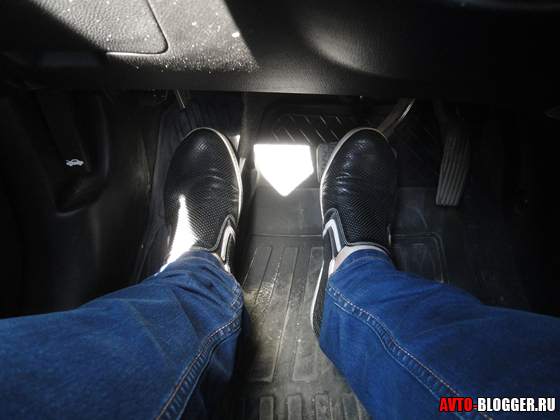
squeeze out
3) Insert the key into the ignition - turn (unlock the steering wheel) - start the engine. Without releasing - the brake.

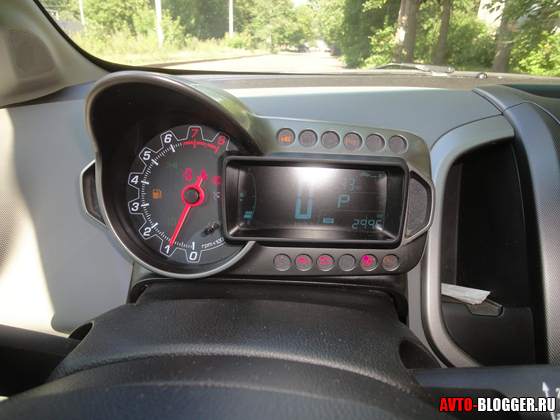
start the engine
4) Next, you need to move the gear selector to the "D" drive position (fully automatic switching option) or the "M" manual (imitation of a mechanical shift, read the article). All shifts are made with the brake pedal depressed.
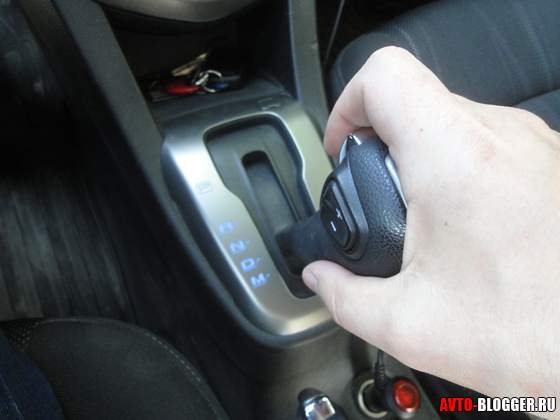
we translate the selector into - "D - drive"
5) Now it is enough to release the brake pedal and without even pressing the "gas" - the car will start moving. If you need to accelerate, press the gas pedal and the car will move faster.
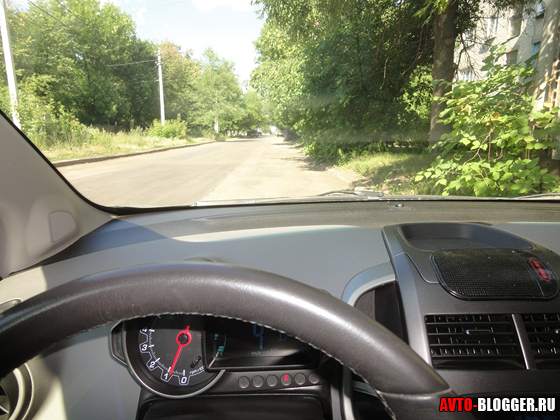
the car will go
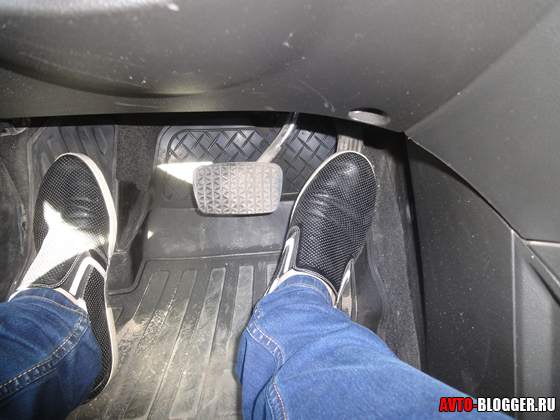
This is how easy it is to drive a car with an automatic transmission.
Now a little about common mistakes
1) Drivers who transfer from mechanical box(like me), they are used to working with two feet - the right one is responsible for the gas and brake, but the left one presses. This habit remains on the machine, but it's not right! When driving a car with automatic transmission, the left leg is not needed at all, a special stand has even been invented for it. All movements occur with one right foot, that is, braking and pressing the gas pedal. If you try to brake with your left foot, nothing good will come of it - the car's braking will be hard and sharp (tested many times). So remember - on automatic transmission we use only one leg - the right one! The left one is resting.
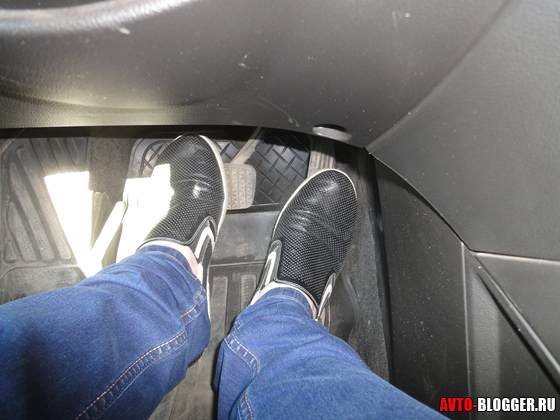

2) Again, many "immigrants from mechanics" do not understand how to behave at traffic lights and car stops. Previously, they had to turn off the gear and put the car in "neutral". They also try to do with automatic transmission! DO NOT do this, it is not necessary, and it is not necessary! At the traffic light, it’s enough to take your foot off the gas pedal and press the brake pedal, after the green light is on, press the gas and drive off. No shutdowns needed.
As usual, guys, for those who did not understand the information from the photo of the article, I will definitely post the video version at the end. So be sure to look, everything is detailed there with all the subtleties - I think it will be useful to you.
Detailed video
An automatic transmission makes life much easier if you know how to use it - especially in urban mode - before traffic lights, in traffic jams on steep slopes (hills). No clutch - no problem, it's easier to start - simple, even beginners feel much more confident behind the wheel.




